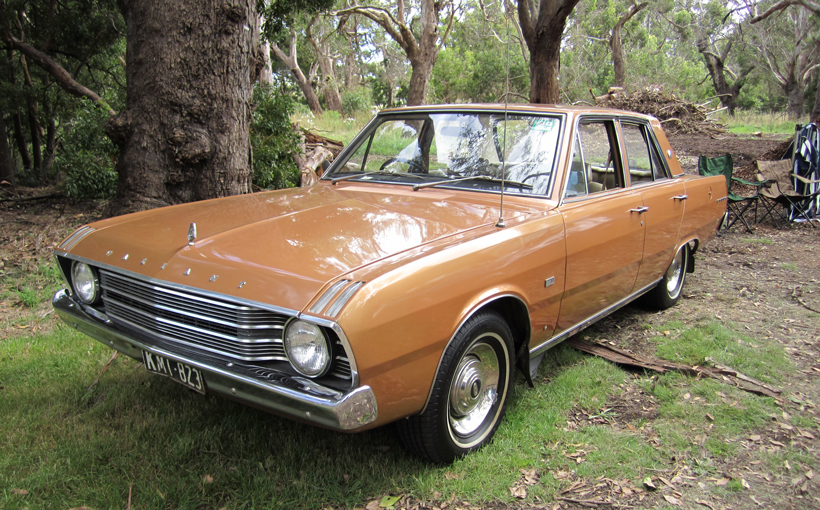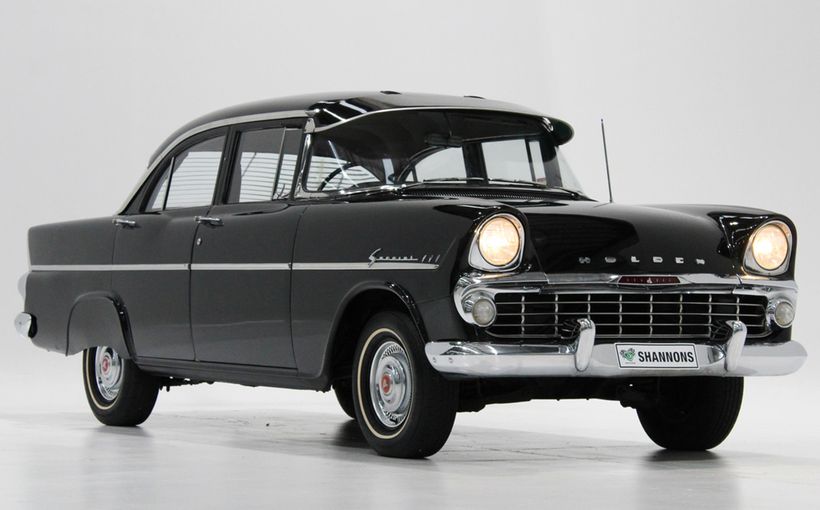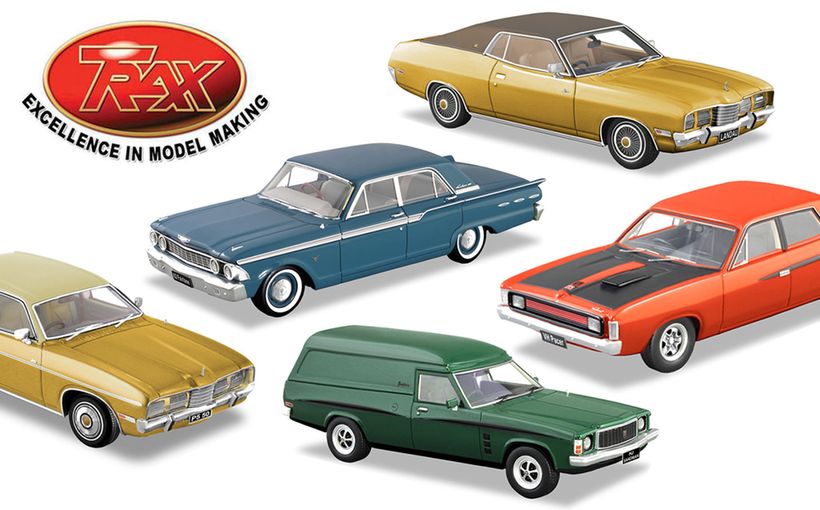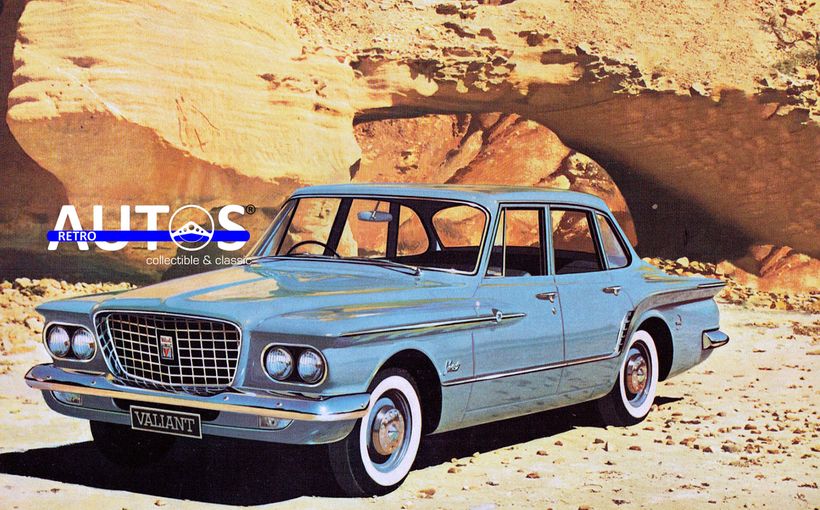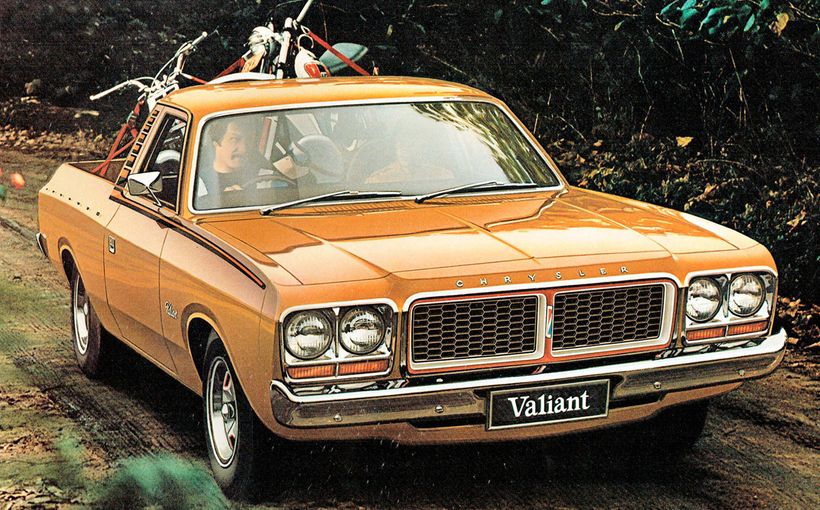1969-70 Chrysler VF Valiant: Beautiful Beast or Endangered Species?
By
JoeKenwright -
30 March 2015

This VF Regal represented everything Australians loved about Valiants except by 1969 it was more of the same compared to rivals. Cost-cutting which limited the number of passes through the panel presses dictated the slab sides and almost flat panels.(Photo from commons.wikimedia.com)
After early Valiants applied the blow torch to Holden and Ford to lift their game, Australians regarded these local Chrysler models with affection and respect. Because the VE Valiant could never convincingly top either the combined XT Falcon/ZB Fairlane range or the Holden HK range in 1968, expectations for the VF Valiant at its overdue March 1969 release were high. Instead, Chrysler’s bold attempt to present the VF as The Beautiful Beast proved one of the most ambitious claims of the era.
The only beast in the VF’s 1969 release was the acute shortage of development funds generated by the US parent company’s woes. This was at a time when the Australian models from Holden and Ford were freshened up at an unprecedented rate with major styling changes and mechanical upgrades. Not only did this force local Chrysler staff to become amazingly innovative on very tight budgets, the Valiant benefitted from extra quality and equipment in areas that did not require expensive tooling.
As a local 1960s model, the VF must be regarded as a high point in terms of body configurations, metallic colour choices across the range, base engine output and performance, trim and build quality and equipment. For a 1966 model, the VF Valiant would have been outstanding by any standard. As a 1969 model, the VF was too late on several critical scores including styling, cabin size, wheelbase, track and a V8 Bathurst hero model. The frustrating part was that Chrysler’s US parts bin contained everything the local arm needed for domination.

Ambitious advertising claim was undermined by lack of hero V8 model and the shortest wheelbase and narrowest track in its class. Plain entry level detailing including shortened side strip was not consistent with local expectations for a cut-above Valiant.
Even if the base Valiant sedan was still more powerful than base rival sixes, calling it a beast misrepresented the torquey smoothness and syrupy delivery that distinguished six-cylinder Valiants especially the VF, the last local model with the slant six.
Although the new 318 V8 option appeared to be bigger and more powerful than its 5-litre rivals, even Chrysler admitted its power outputs were conservative for long life and smooth driving.
In 1969, there were only three local candidates that could live up to The Beautiful Beast: XW Falcon GT/GT-HO, ZC Fairlane 351 and the HT Monaro GTS 350. A VF Regal SE 340 or Pacer R/T 340 could have been contenders except there weren’t any.
Yet if you were prepared to look in the fine print of the VF brochures, there were several standout models worth a second look today.

Superb Regal detailing broke up the slab sides and made the VF look far more expensive than the Regal’s relatively few detail touches would suggest. Even if it was showing its age, many local buyers could still relate to the Regal’s honest and unpretentious presentation.
The Range
The bottom line is that Chrysler Australia, like Holden, backed the wrong horse in 1967 after the VE arrived significantly smaller than the XR Falcon in several key areas.
Unlike Holden, which delayed its 1967 model until 1968 to correct its smaller size, Chrysler was stuck with these fundamental packaging shortfalls until the 1971 arrival of the
VH.
Chrysler US in 1967 differentiated its Dodge and Plymouth versions of the Valiant by boosting the Dodge Dart wheelbase to the same 111 inch/2819 mm as the Falcon. The Plymouth Valiant was smaller with its 108 inches/2743mm wheelbase or closer to where Holden originally intended to position the
HK series.

Chrysler Australia’s problems started with this 1967 US Valiant which demanded all new tooling from top to bottom yet would have sold no better than the VE-VF-VG derived from pre-1967 local tooling. Note the entirely different rear door profiles and proportions between the front and rear axles despite identical wheelbases.
The VE was given the Plymouth’s 108inch/2743 mm wheelbase to counter Holden’s earlier 106 inch/2692mm wheelbase and the early Falcon’s 109.5 inches/2781mm wheelbase. Against the HR Holden and XP Falcon, the local VE might have been a brilliant compromise. The Dart, which looked like a stretched Valiant, had overhangs way too long for rural Valiant buyers.
For 1967, Chrysler was forced to go it alone with VE packaging and panels totally removed from the new 108 inch wheelbase US Plymouth Valiant to maintain local content. To match the US Valiant’s 108 inch wheelbase, only the VE’s front wheels were moved forward so the previous VC floorpan could remain in local production. Chrysler covered this extra frontal length with the 1967 Dodge Dart front clip which cheaply propped only the headlights ahead of the original bonnet line. The extra length at the front was as fake as the
HD Holden’s kidney slicers
and the
P76’s die cast nose piece.
The VE’s rear guards were also extended beyond the bootline, a repeat of the front strategy to hide the shorter VC rear section. Their rear edges housed unique contoured C-section tail lights in the same way that the HD Holden and several Rambler models used curved tail lights to create fake length. For the P76, Leyland added die cast tail light extensions, a ploy that Chrysler and Holden had used first but more of that shortly.

The VF Valiant had all the ingredients to be the class leader in 1966 against the XP Falcon and HR Holden, all of which were possible as the VF was a local evolution of the VC. By 1969, that opportunity had gone. (Photo from guitargear.net.au)
Because there was no money left in the threadbare Chrysler corporation to deliver the full-sized VH already needed in 1969, the VF was the second stage in disguising what still wasn’t there while boosting local sheet metal content.
As a result, the VF series must rate as one of the most handsome of all local Valiants even if it falls short of “beautiful”.

The VF dash was an evolution of the VE with extra padding, concertina steering column section and centre pad steering wheel. This example’s column selector, plainer trim and lack of centre console belong to a Regal, not the top shelf 770.
There are good reasons for this. The VF introduced no less than three wheelbases (the Sedan/Wagon’s 108 inch/2743mm, the Hardtop’s 111 inch/2819 mm Dart wheelbase and the VIP’s stretched 112 inch/2845mm). Chrysler no longer had to offer a VIP sedan pretending to be a ZA Fairlane rival on a Valiant wheelbase that was a massive 8 inches shorter as it did for the VE series.
The VF was the product of an almost identical process to the HR Holden after the VE’s fake body lengthening devices were either shaved off or filled out to deliver a more balanced design.

The VF facelift involved far more than reversing the grille shape compared to the VE above it. The front structure ahead of the radiator was changed as real length was added to the centre of the VF body front and rear. (Photos from slantsix.org and powerhousemuseum.com)
Press reports at the time stated that the VF’s grille was simply reversed from the VE’s concave shape to convex. It involved much more than that and was a testament to the Aussie industry’s ingenuity and what could be achieved on such tiny budgets.
The key was an innovative change to the radiator support panel and bonnet catch support which allowed the VF bonnet to match the full length of the front guards and follow their rakish side profile. It marked a subtle return to a more aggressive front that distinguished earlier Valiants. It also left the engine room ready for the hemi and allowed the insertion of quad headlights for the VIP, a feature the VE’s Dart front could not accommodate. The downside is that it made retro-fitting the US Dart front to local VF Hardtops an involved process.
The clever bit was punching slots in the tops of the front guards so the indicators could sit above the headlights. This allowed a slimmer bumper that made the front look even sleeker. So tight was the budget, the same bumper had to fit the new rear. It would again be recycled in 1976 for the CL facelift!

Although they looked sleek and had updated tail lights, the VF Safari wagons suffered most with the short wheelbase, shallow load area and long rear overhang compared to rivals. The UK export Regal Safaris found a market with undertakers while the rear section was exported to South Africa where it was mated to the latest US Valiant front after the US wagon was dropped.
As for the HR Holden, the VF facelift lined up the rear guards with the boot lid for the same effect as the front. After the VE’s styling creases were removed from the bootlid, the smooth, rounded boot line would have been too close to the rear of an HR Holden.
The clever bit was to cut the ends off the VF’s rear guards and cap them with body colour die cast body sections that matched the boot profile and covered the tail lights. This replicated the effect of cutting the tail lights into the rear panels, a hot rodding fashion at the time. Underneath they were no different to an add-on tail light ready to be exposed and highlighted in chrome for the VIP. Like the P76 which replicated this process, the new VF lights featured side repeater lights, a welcome change as the sides of the VC and VE Valiants could become invisible at rural intersections at night.

Following Ford designer Elwood Engel’s move to Chrysler, the Ford influence started trickling into Australian models. In generational terms, the VF combined the 1965 Galaxie’s flat lines with the 1966 front shown here, both of which sold in Australia, and might explain why the VF styling had so little impact three years later. (Photo from en.wikipedia.org)
Although the VF looks smart today, it didn’t look any younger than the VE in 1969 as it was still a full generation behind the Mustang proportions and grille of the clever XW Falcon facelift. The HT Holden with its rounded sides, detailed grille and flush rear quarters was so far ahead that it could have faced the 1971 VH. Despite VF claims of extra leg room, trim and “cushier seats”, the cabin was still relatively small and the upright seating position was closer to 1965-66 models than the more lounge-like experience in the bigger XW and HT.

This period Modern Motor comparison confirms that the VF Valiant was the longest by a massive 8 inches/203mm, all in overhang, on a wheelbase 3 inches/76mm shorter. Also smaller in width and track, the VF had no chance of challenging its rivals’ short boot, long bonnet, wide track looks. Yet the slant six still kept it in front on a bang for buck basis even the VF was much heavier than a Holden.
Chrysler was left to peddle a new padded steering wheel, collapsible steering column section, extra padding on the dash, power windscreen washers, “big beam” headlights, wider 5 inch wheels and padded sun visors, none of which gave it a real edge over its rivals. Yet the lovely slant six engine, with two class-leading outputs, was still there at its best ready to haul whatever could fit into the VF’s proper family car boot. A new 318 V8 was optional across the range along with Australia’s first factory “Airtemp” air-conditioning. This quickly set an industry standard after it was based on parts for Chrysler’s larger US models.

The VF Hardtop’s imported Dodge Dart panels from the windscreen back (which were combined with the VE front in the US) were from a larger Valiant derivative hence the extended rear guards, long overhangs and extra wheelbase over the VF sedan. In feel and style, it was more like a smaller Dodge Phoenix. As a Regal 770, extra grunt and nimbler handling were a bonus. (Photo from commons.wikimedia.com)
The VF Pentastars
Regal 770
Damned to obscurity by its meaningless 770 tag, this standout model pre-empted the Fairmont GXL/Ghia by seven years. Regal SE or Regal Fireball might have provided more clues on what was lurking here. Chrysler intended to drop the slow-selling short wheelbase VE VIP altogether but instead released two slow-selling VF models to replace it. This did deliver, it must be said, a net sales gain! The SWB VIP was hastily re-badged as the Regal 770 so the extended wheelbase VIP could stand alone.
An exclusive Fireball version of the 318 V8 was available only in this model and the top VIP. To deliver its extra 20bhp/15kW and a similar increase in torque over the normal 318 option, Chrysler raised the compression ratio, gave the heads bigger ports and a camshaft to match during local assembly of the new V8, reportedly to counter the loads of the extensive luxury items. Contrary to common usage, the standard 318 V8 option was not a Fireball, in both senses of the word.

This rare VF Regal 770 coupe, once owned by Shannons Club motor racing expert Mark Oastler, with its exclusive Fireball V8 engine and US Torqueflite auto was a real sleeper and a beautiful car. Like the VF sedan, the extra Regal touches transformed the Hardtop into something special but the 770’s VIP interior took it to another level again. Today’s owners would probably refit the original mirrors to enhance this car’s lovely period bling.
Even with mandatory Torqueflite (the US A904 autobox, not the local Borg-Warner 35 fitted to most VF sixes), the Fireball would have made a great Pacer option package and an even better stand-apart Regal model with Ford’s GS/GT-style tweaks. Tonsley Park was still the epi-centre for grey cardigans so buffalo-grain trim and map pockets ruled the day. It ran to 112mph/179km/h but switching on the air-cond would pull this back to 160km/h in an instant. The standing quarter time was 17.4 seconds. Both figures were significantly quicker than the bare bones Pacer manual even with the auto and kilos of luxury gear.

Rare VF Hardtop in base level looked better finished than sedan with full length side strip. If you were shopping in the lower end of the market, it was hard to match the presence and the feel of a glamorous US pillarless coupe on offer here. (Photo from commons.wikimedia.com)
Hardtop
Desperate times required desperate measures so if Ford could add an imported coupe roofline to the XM/XP Falcons, why couldn’t Chrysler add the entire Dodge Dart rear section to the VF front? A not unpleasant surprise that appeared later in September 1969, the Hardtop finally matched the 111 inch/2819 mm wheelbase of its rivals. Its long overhangs, which left the VF Hardtop 4inches/102mm longer than the long wheelbase Fairlane, highlighted why Chrysler had to say no to a four door Dodge Dart.

If there was a “beautiful beast” in 1969, Holden’s HT Monaro GTS 350 was the only local car that lived up to that title in the showrooms and at Bathurst. For 1969, Holden gave the HT Kingswood sedan the Monaro’s integrated rear pillars and quarter panels for a similar look while Ford’s base Falcon shared the wild GT 351/GT-HO body, both leaving the VF claim looking a little hollow.
Following Holden’s lead with a base Monaro, there was a plain wrapper VF Hardtop which seemed to defeat the purpose behind the extra bling of the pillarless hardtop body. There was no Pacer or sports version, yet, but the sleek and rakish US-body style which looked quite different with the local VF front, was more about personal luxury than the fastback Monaro. The VF Hardtop sleeper was the rare and desirable Regal 770 version with Fireball power, another overlooked VF model that deserved a special badge and recognition.

Although the VF VIP had a big boost in wheelbase, it was only an inch/25.4mm longer than the Kingswood and Falcon wheelbase. Would the VIP body have made a better baseline sedan for all VF Valiants? (Photo from wallpaperup.com)
VIP
The VF VIP (Valiant was deleted) was a proper wheelbase stretch after the extra 4 inches/102mm went into rear legroom. It also arrived later, in May 1969. There were no ugly blanks or extra windows behind the rear doors which confirm that Chrysler was the first local manufacturer to tailor the rear doors and roof to match the extra wheelbase, something not repeated until 1973 with the P5 LTD.
The VIP’s padded roof, another local first, was probably added, as it was for the P5 LTD, to hide any budget roof panel stretches. The smaller rear screen suggested limo-style privacy. The VF’s rear lights were fully visible and looked different with extra chrome. Unlike the HT Brougham on its similar 111 inch/2819 mm wheelbase, the VF VIP was a beautifully balanced design that did not look like a stretch. The main criticism was the tiny quad headlights which were not as good as the new standard single headlight system.
Like the Fairlane, there was a bench seat fleet version with the 225cu in 160bhp slant-six, which was adequate when the Ford six wasn’t, and the rare 318 Fireball top shelf model with bucket seats and head rests. Still too close to the Valiant in looks on a wheelbase 4 inches/102mm too short to be a threat to the more heavily-differentiated ZC Fairlane, the VF VIP was the first step in the right direction.
The VF VIP body was so tidy that it might have been more useful as the standard body and given all VF Valiants an edge. After all, its wheelbase was closer to its Falcon and Kingswood rivals than the Fairlane while offering more boot room and cabin space. Its late arrival suggests that Chrysler was more intent on plugging a leaky boat than confronting the big picture.

For not much more than a base Valiant, the VF Pacer was an outstanding package after Chrysler drew on several talented Adelaide suppliers. A Fireball V8 R/T option with carpet, driving lights, dual exhausts (on their own they would have liberated considerable extra grunt) and special six inch wheels would have made a desirable hero model even as an auto only.(Photo from chryslerclubvic.org)
Pacer
The Pacer was a cheap upgrade of the base VF Valiant and pre-empted Holden’s similar HQ Belmont-based SS by three years.
Colours were limited to Wild Blue, Wild Red and Wild Yellow but the blue is also known as Cosmic Blue and the yellow, Iris Yellow. There were white VF Pacers and several late examples came in the VG’s light blue, Thar She Blue.
Blackouts were carefully added around the base VF shell. The VF grille looked its best on the Pacer with upper and lower blackouts divided by two fine red bars. The Adelaide display company Display Masters developed the detailed stripe and decal package. A square exhaust tip highlighted the sportier system.
The Pacer’s full wheelcovers were made here and unique to Chrysler Australia. For the local industry, they were a close second, arriving within months of the Monaro’s similar wheelcovers. Unlike others, they were designed not to fly off and looked sharp.

Although the rubber mats have long since gone on most VF Pacers, the black on white dials, unique tombstone front seats, quaint dash top tacho and floor shift have stood the test of time. It was a good enough starting point for an entry V8 package like the HQ SS except Chrysler Australia seemed intent on offering more luxury packages. (Photo from valiantpacers.com)
There were no local four speed manuals so Chrysler fitted a floor change to the Borg-Warner all-synchro three speed. Because reverse occupied the first gear slot for a four speed without a lockout, you could imagine the dramas.
An aftermarket VDO Panoramic tacho was moved from its proposed position ahead of the windscreen to the top of the standard dash. An Adelaide seat supplier produced a special Pacer tombstone seat that minimised whiplash, several years ahead of legislation. Base rubber mats and drum brakes plus no heater or radio kept the price to an astonishing $2798. Although the Pacer sold reasonably well, (4012 sedans plus 20 wagons according to Gavin Farmer in “Great Ideas in Motion”) it could do little to enhance the Valiant image. Some suggest it damaged it when it wasn’t the expected hero V8 model.

There was a time when Chrysler never had to sell Valiants on price so there were some who felt the VF Pacer’s packaging and sales pitch went too far the other way. Note external tacho changed at the last minute before release. Wider track and lower ride height made a huge difference to how the Pacer looked and felt on the road.
The VF Pacer’s slant six was a high compression version of the twin-throat 160bhp engine (9.2:1 from 8.4:1) with twin branch exhaust headers that fed into a free flowing exhaust system for an extra 15 bhp and a total of 175 bhp/131kW. A half inch (13 mm) drop in ride height, heavy duty front anti-sway bar, 5.5 inch wheel rims and front and rear track increased by a full inch (25.4mm) tightened-up handling.
Tyres were red-line bias-belted cross ply similar to those fitted to early Monaro GTS models. The dud RHD Valiant steering box mounting and its vagueness would colour all VF road tests especially the Pacer as its extra grip and cornering power made it worse.
A top speed of 107mph/171km/h and a standing quarter of 17.8 seconds were slower than the Regal 770 but once the Pacer was in second gear it would draw away from the Regal 770 after 50mph/80km/h. For drivers ready to move on from their hot R-series Valiants and EH Holdens, it was perfect but only if you ticked the $55 disc brake option.

The last word in VF luxury was this Regal 770 cabin with Australia’s first factory air-conditioning, flat buckets with lurid buffalo-hide trim, centre console and all-states radio. Just a few tantalising details away from being a formidable and tasteful Fairmont GS 302 rival, Tonsley Park seemed intent on tailoring the Regal 770 for an Adelaide-based bookie travelling between national turf meets, rodeos and country and western concerts.
Conclusion
Although the VF appeared to post strong sales figures (52,933 according to Gavin Farmer, give or take 11 sedans, and significantly higher than the VE’s monthly rate), insiders recall that once rival 1969 releases were established, the VF’s healthy sales rate dropped away quite suddenly. The VF model run was cut short at just 11 months. As the VH stretched local funding and resources to the limit and wouldn’t appear until mid-1971, the VG with its new hemi six was rushed out to maintain momentum and vital revenue to pay for the new car. That leaves the last slant six local Valiant as not only the most powerful and refined of its kind, its wide choice of body styles and models makes each one relatively rare.




















